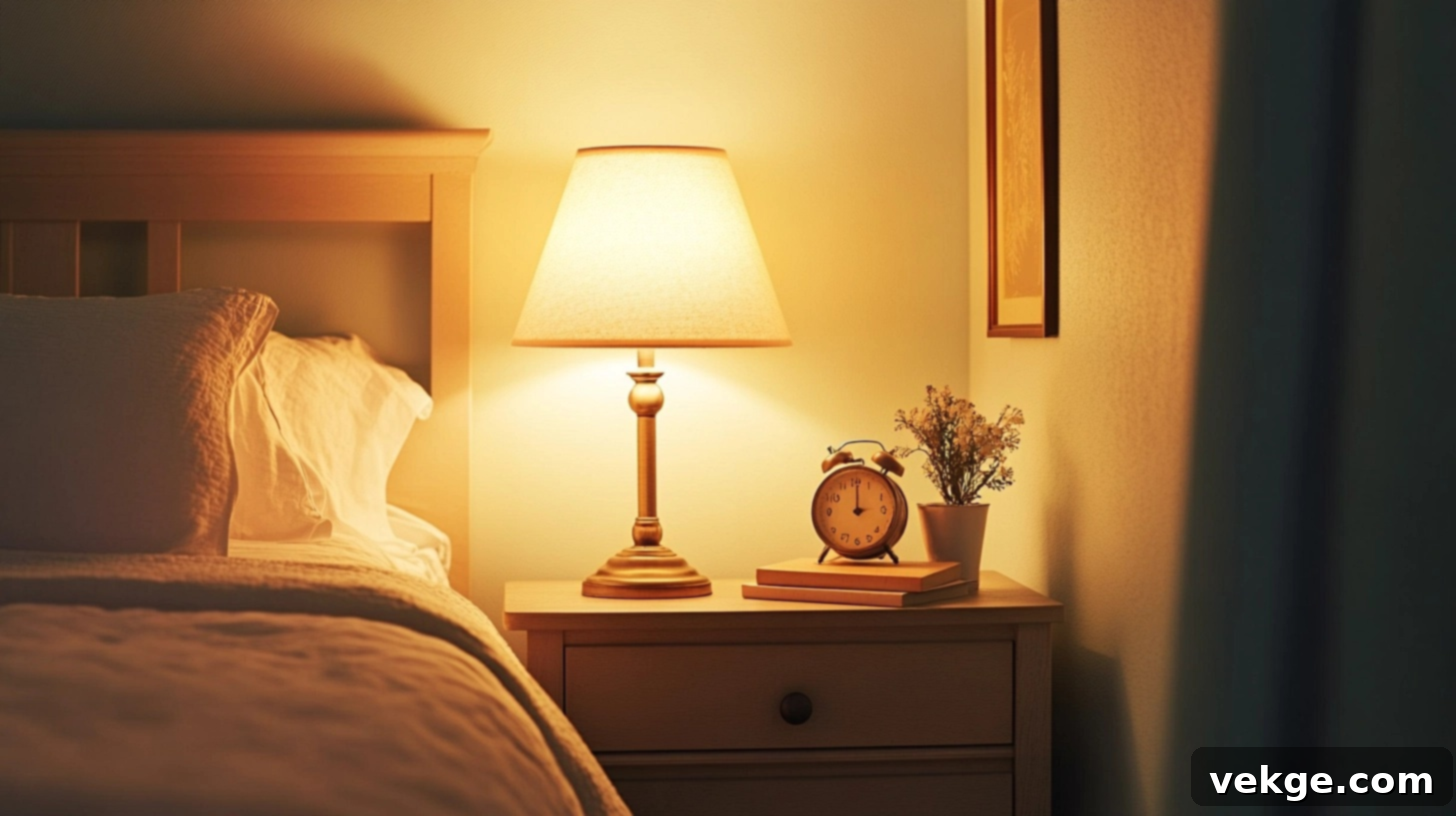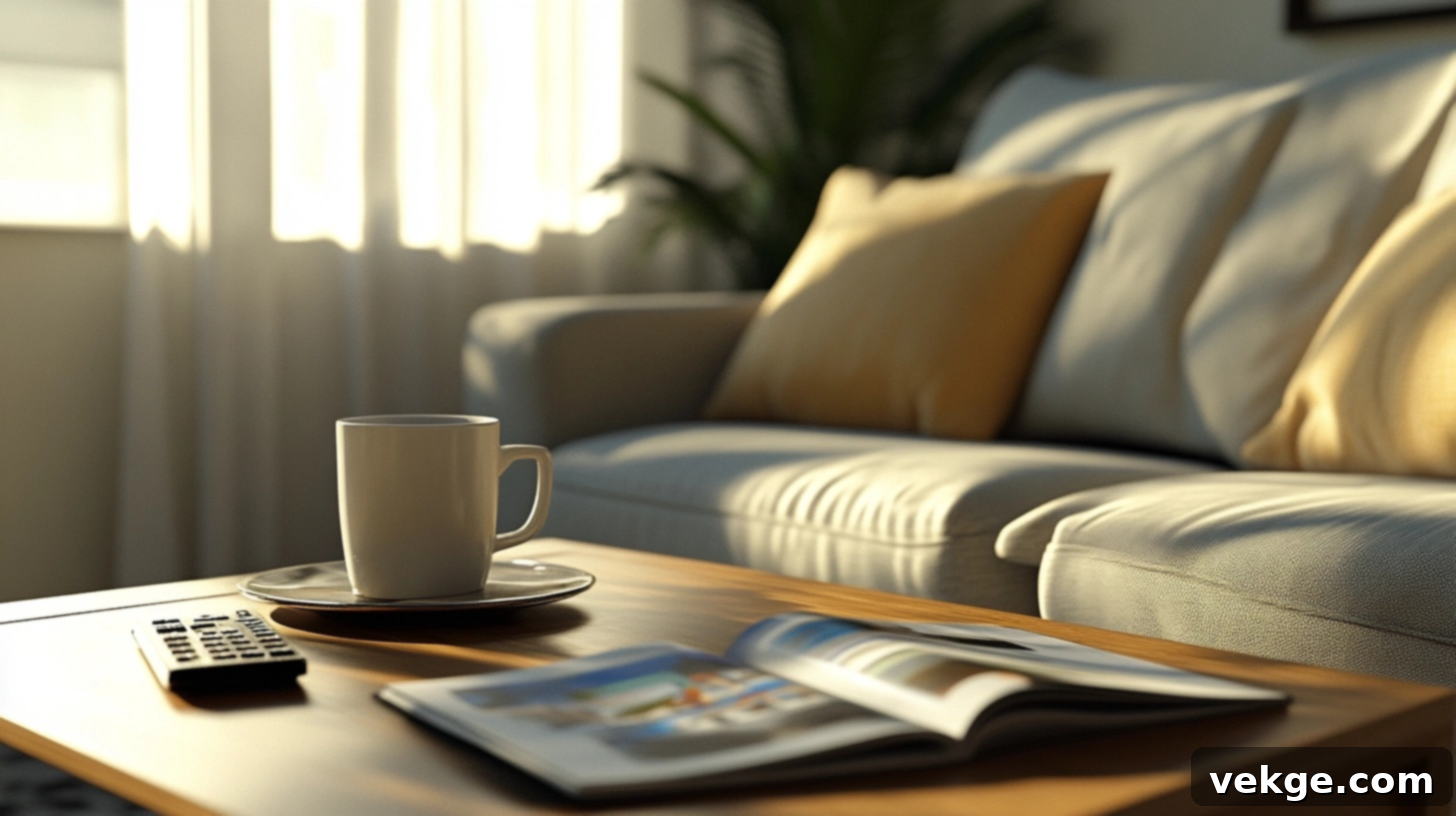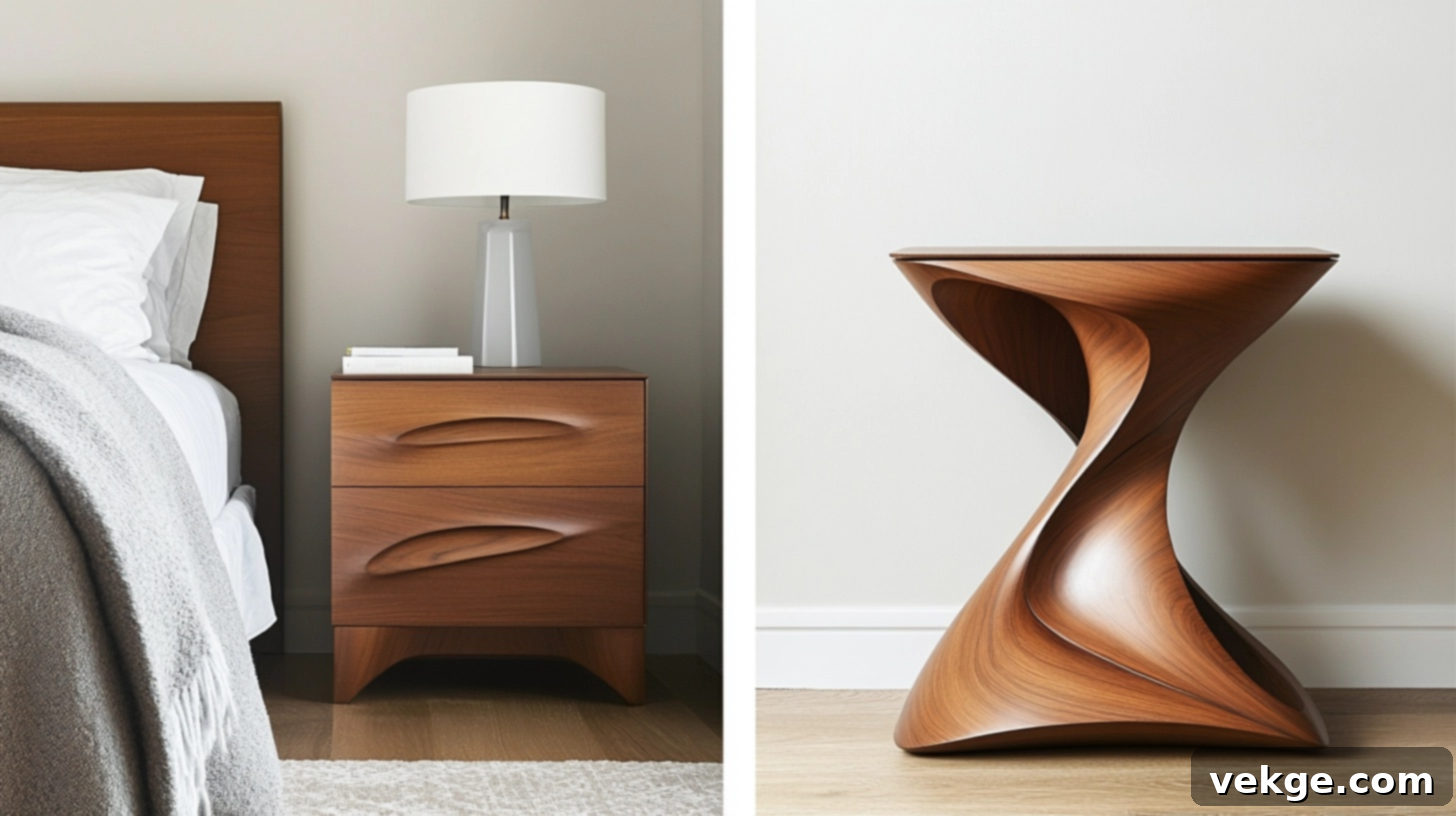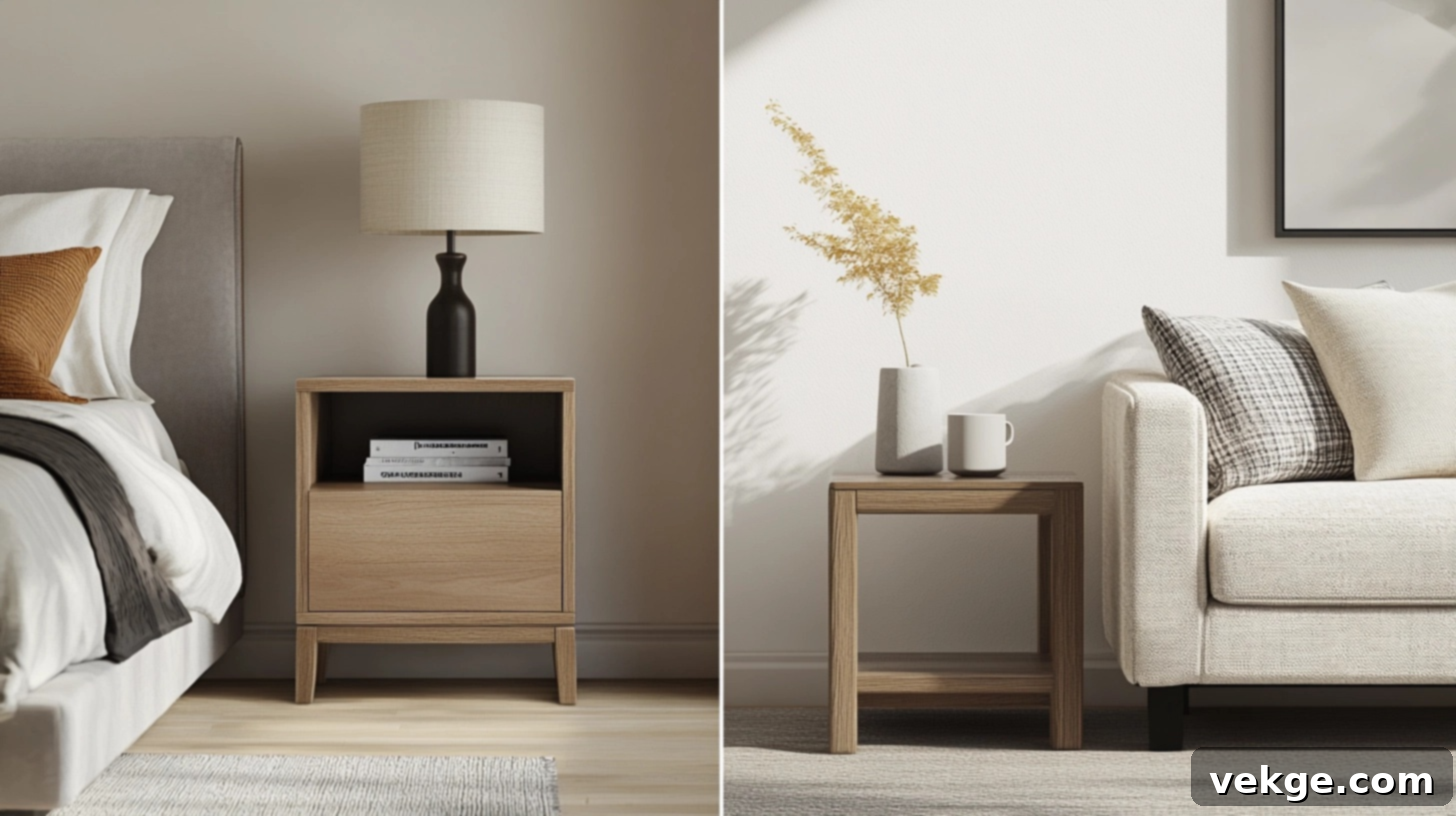Nightstand vs. End Table: Your Ultimate Guide to Choosing the Perfect Sidekick for Your Space
Ever found yourself staring at two seemingly similar tables, wondering if they’re a nightstand or an end table, and more importantly, which one you actually need? You’re definitely not alone. While they might appear to serve similar purposes – holding a lamp, a drink, or a book – these two common pieces of furniture are designed with distinct functions and environments in mind. Choosing the wrong one can throw off the aesthetics of your room, hinder its functionality, and ultimately leave your space feeling less cohesive and efficient than it could be.
This comprehensive guide is here to clear up all the confusion. We’ll delve deep into what defines a nightstand and an end table, explore their primary placements and typical uses, and highlight the key differences that set them apart. Beyond just identifying them, you’ll learn practical tips on how to select the perfect table tailored to your specific needs, the dimensions of your room, and your personal style preferences. We’ll even explore if and how you can successfully swap them, offering creative solutions for versatile living.
By the time you finish reading, you’ll be equipped with all the knowledge to confidently choose the ideal table, ensuring both beauty and utility in your home. Ready to stop guessing and make a smart, informed decision that enhances your living or sleeping area? Let’s embark on this journey to perfect your furniture choices.
Understanding Their Primary Purpose and Placement
When you’re furnishing your home, especially with smaller, functional tables, knowing the intended role of each type is crucial. Both nightstands and end tables are invaluable for providing accessible surfaces and often additional storage. However, their design and typical features are optimized for very different rooms and daily routines within your home.
Nightstand Basics: Your Bedside Companion

- Designed for bedroom use: Nightstands are specifically crafted to sit next to your bed.
- Common items stored: Lamps, alarm clocks, books, water glasses, phone chargers, personal medications, and reading glasses are frequently placed here.
- Key Function: To keep essential items within arm’s reach while you are in bed, promoting convenience and relaxation.
A nightstand is more than just a surface; it’s an integral part of your bedroom’s functionality and comfort. These tables are designed to be your steadfast companion through the night, holding everything you might need from the moment you settle in until you rise. They frequently feature built-in storage options like drawers or open shelves, perfect for stashing away books, eyewear, sleep masks, tissues, or even a glass of water, keeping your personal space tidy and organized. The top surface is typically reserved for a bedside lamp, an alarm clock, and your phone for easy charging access.
One of the most critical aspects of a nightstand’s design is its height. It is generally engineered to align with the top of your mattress, or be just slightly lower, ensuring that you can easily reach for items without straining or having to get out of bed. This ergonomic consideration is paramount for a restful and functional sleep environment. In terms of aesthetics, nightstands often complement bedroom furniture sets, contributing to a harmonious and serene atmosphere.
End Table Basics: The Living Room’s Functional Accent

- Intended for living rooms or seating areas: End tables are placed adjacent to sofas, loveseats, or armchairs.
- Used for: Beverages, TV remotes, reading materials (magazines, newspapers), decorative accents, and small electronic devices.
- Key Function: To provide a convenient surface for items used while relaxing in a seating area, enhancing comfort and accessibility.
End tables are the unsung heroes of the living room, strategically positioned to support your relaxation and entertainment needs. They provide that essential surface for placing your coffee mug, a refreshing drink, the ever-elusive TV remote, or your current reading material while you unwind. Unlike nightstands, end tables typically have a more decorative role in addition to their utility, often holding a stylish table lamp, a vase with flowers, or a few carefully chosen decorative objects that reflect your personal style.
Similar to nightstands, the height of an end table is a crucial design element. They are usually designed to be roughly the same height as the arm of your sofa or chair, making it comfortable and natural to reach for items without excessive bending or stretching. While some end tables might offer a lower shelf for magazines or a small storage basket, they generally prioritize surface space and aesthetic integration into the living room’s decor over extensive enclosed storage. Their versatility in style, material, and shape allows them to either blend seamlessly with existing furniture or act as a striking accent piece.
Key Differences Between Nightstands and End Tables
While both nightstands and end tables serve as convenient surfaces, their core design, features, and intended use create significant distinctions. Understanding these differences is vital for making an informed choice that truly elevates your space’s functionality and aesthetic appeal. Here’s a detailed breakdown of what sets these two furniture pieces apart:
| Feature | Nightstands | End Tables |
|---|---|---|
| Primary Placement | Specifically designed to be placed beside beds in bedrooms. Their location is dictated by the bed’s position. | Positioned next to sofas, loveseats, or chairs in living rooms, family rooms, or other seating areas. |
| Storage Capacity | Often prioritize storage, commonly including one, two, or even three drawers, or a combination of drawers and open shelves for personal items. | Typically offer less enclosed storage. They usually feature open bottoms, a single lower shelf, or no storage beyond the top surface. |
| Optimal Height | Generally taller, ranging from 24-28 inches (61-71 cm) to align comfortably with the height of most mattresses. | Usually shorter, typically 22-26 inches (56-66 cm) to match or slightly exceed the arm height of sofas and chairs. |
| Typical Width & Depth | Tend to be slightly larger, often 18-22 inches (46-56 cm) wide and deep, to accommodate bedside essentials and provide ample storage. | Can be more varied but are often more compact, ranging from 14-18 inches (36-46 cm) wide and deep, to fit smaller spaces or act as accent pieces. |
| Specialized Features | May include built-in USB ports, power outlets, charging stations, discreet cable management, or integrated reading lights to support modern bedtime routines. | Focus more on aesthetic appeal and surface utility. Features might include unique materials, distinctive shapes, or integrated cup holders, but rarely power outlets. |
| Core Function | Holds essential bedtime items like alarm clocks, books, reading glasses, medications, water bottles, and phone chargers. Promotes convenience for personal routines. | Supports living room activities by holding drinks, snacks, TV remotes, magazines, and decorative accents. Enhances comfort during social or relaxation times. |
| Design & Aesthetic Focus | Often designed to match or complement bedroom furniture sets, contributing to a restful and cohesive sleeping environment. Styles tend to be softer or more traditional. | Offers greater design versatility, serving as accent pieces that complement or contrast the living room decor. Can feature bolder shapes, materials (glass, metal), and modern finishes. |
Can You Successfully Swap Nightstands and End Tables?

While nightstands and end tables are purpose-built for their respective spaces, the lines between their uses can sometimes blur. With a little creativity and a few strategic adjustments, you can often repurpose one for the other, especially when faced with specific space constraints, a need for more storage, or a desire for a particular aesthetic. The key lies in understanding the inherent differences and compensating for any functional gaps.
Using a Nightstand in the Living Room
A nightstand can surprisingly excel as an end table in a living room, particularly if you have a significant need for extra storage. Its drawers are perfect for discreetly stashing away TV remotes, gaming controllers, coasters, reading glasses, and other small items that often contribute to clutter on open surfaces. However, it’s essential to be mindful of a few considerations: nightstands are typically taller and often bulkier than traditional end tables. This might make them appear somewhat oversized or out of proportion next to the sleeker arms of some sofas.
To ensure a nightstand seamlessly integrates into your living room:
- Choose Wisely: Opt for a nightstand with clean lines and a contemporary or versatile design that won’t look out of place. Avoid overtly “bedroom-y” styles.
- Harmonize Materials and Colors: Select a nightstand made from materials or finished in colors that complement your existing living room furniture and decor scheme. A cohesive palette is key.
- Verify Height for Comfort: Before committing, ensure the nightstand’s height allows for comfortable reaching when you are seated on your sofa or chair. It should feel natural, not a stretch or a reach down.
- Consider Scale: Pay attention to the overall scale relative to your sofa. A very large nightstand might overpower a small sofa.
Using an End Table as a Nightstand
Conversely, an end table can serve as a nightstand in a pinch, or as a minimalist option. The primary drawback, however, is their usual lack of enclosed storage. This absence of drawers can quickly lead to a cluttered bedside if you have numerous personal items like books, chargers, hand creams, or medications that require a dedicated home.
If you decide to use an end table by your bed, thoughtful planning is essential:
- Enhance Storage Creatively: Compensate for the lack of drawers by incorporating decorative baskets or fabric bins on a lower shelf, or by using a stylish bedside caddy or organizer that hangs over the side of the bed.
- Integrate Auxiliary Storage: Consider pairing the end table with a small wall-mounted shelf above it or a slim chest of drawers elsewhere in the room if you genuinely need more storage.
- Prioritize Height Alignment: Always check that the end table’s height aligns well with your mattress. If it’s too short, you might find yourself straining. Furniture risers can be a discreet solution if a slight height adjustment is needed.
- Consider Essential Items: If you only need a spot for a lamp and your phone, a simple end table might be perfectly adequate.
Matching Style to Your Room’s Aesthetic
Regardless of which type of table you choose or how you repurpose it, its design should always complement the overall style and ambiance of the room it inhabits. This ensures visual harmony and a well-curated look.
- For Bedrooms: Focus on creating a serene and restful atmosphere. Look for tables with softer finishes, rounded edges, or coordinated sets that blend seamlessly. Warm wood tones, muted colors, or classic designs often work best to promote relaxation.
- For Living Rooms: You generally have more freedom to experiment with styles. End tables can act as focal points or accent pieces. Consider bold shapes, industrial metals, sleek glass tops, or interesting textured finishes to add character and visual interest to your decor.
Choosing the Right Material and Shape for Longevity and Look
The material and shape of your table significantly impact its durability, maintenance, and how it fits into your room’s design language.
- Nightstands: Solid wood or painted wood finishes are popular and durable choices. They offer a classic, comforting look. For a versatile piece that could potentially be swapped, choose clean-lined designs. Avoid overly heavy or ornate pieces if flexibility is a goal, as they might feel out of place in a living room.
- End Tables: Glass tops are excellent for high-traffic living areas, as they are easy to clean and visually light, preventing a room from feeling cluttered. Metal and wood combinations suit modern, industrial, or casual living rooms, offering a blend of warmth and contemporary edge. Stone or marble tops add a touch of luxury and are very durable.
For smaller rooms, regardless of whether it’s a bedroom or living space, prioritize clean-lined, minimalist tables. Rectangular or square shapes often fit snugly against walls or sofas, maximizing space. Avoid overly detailed or bulky styles that can visually crowd a compact area, making it feel even smaller.
Buyer’s Guide: Choosing What’s Right for You
Making the final decision between a nightstand and an end table, or even deciding to repurpose one, ultimately comes down to a careful assessment of your specific needs, the characteristics of your space, and your personal preferences. Here’s a detailed guide on what to consider before you make your purchase.
Assessing Room Functionality and Your Daily Habits
Before you even begin browsing, take a moment to deeply consider how the table will serve you in its intended space. Practicality should always be a leading factor.
- For Bedrooms: Envision your nightly routine. What items do you consistently need by your bedside? If you regularly read before sleep, take daily medications, use an alarm clock, wear glasses, or charge your phone, a nightstand with at least one or two accessible drawers is likely indispensable. It keeps clutter out of sight and essentials within easy reach. However, if your needs are minimal – perhaps just a spot for a lamp and a single device – a simpler, open-shelf table or even an end table might suffice, saving space and potentially cost.
- For Living Areas: Observe your habits while seated on your sofa or armchair. Do you frequently enjoy beverages, snacks, or meals there? Is there a designated spot for TV remotes, magazines, or a laptop? Do you need task lighting from a table lamp? Your actual usage patterns are far more important than traditional notions of what tables are “supposed” to be used for. A C-table, for instance, might be perfect for sliding under a sofa for laptop use, whereas a larger end table with a sturdy top is better for entertaining.
Mindful Space Constraints and Ergonomics
Measuring is non-negotiable. Knowing your available space ensures you select a table that fits physically and functions ergonomically without hindering movement.
- In Tight Bedrooms: Look for narrow nightstands, ideally under 18 inches (46 cm) wide, that still manage to offer smart storage solutions. Floating nightstands or corner nightstands are excellent space-saving alternatives, as they free up valuable floor space. Remember to factor in space for opening any drawers or doors.
- For Living Rooms with Limited Floor Space: Consider versatile tables that can be tucked away or serve multiple purposes. Nesting tables can be pulled out as needed and then condensed, while C-tables slide conveniently under the edge of a sofa or chair. Wall-mounted shelving or floating side tables can be a godsend when every inch of floor space is at a premium, offering a surface without a bulky footprint.
- Ensure Adequate Traffic Flow: A common oversight is forgetting about the space *around* the furniture. Aim to leave at least 18-24 inches (46-61 cm) of clear walking space around any table you choose, especially in high-traffic areas, to ensure comfort and safety.
Budget, Quality, and Long-Term Value
Table prices can vary dramatically, reflecting differences in materials, construction quality, and brand. Understanding these tiers can help you invest wisely.
- Entry-Level Tables (Typically under $100): These often utilize engineered wood products like particle board or MDF, usually with a laminate finish. They are suitable for temporary setups, dorm rooms, or if you anticipate frequently redecorating. While affordable, they may not withstand years of heavy use, moisture, or frequent moves.
- Mid-Range Options (Typically $100-$300): In this bracket, you’ll find tables often featuring solid wood tops or frames combined with MDF, better quality hardware (drawer glides, hinges), and more durable finishes. Construction often involves sturdier joinery than simple glue and nails. These pieces offer a good balance of value and longevity for most households.
- Higher-End Tables (Typically $300+): These pieces generally boast all-solid wood construction, premium hardware, superior finishes that are more resistant to scratches and moisture, and often unique design elements or integrated smart features (like hidden charging stations). Expect expert craftsmanship and greater durability that can last a lifetime.
For the best long-term value, prioritize tables made from solid wood in timeless, basic styles. These tend to age gracefully and remain relevant, rather than paying a premium for overly trendy designs that might quickly look dated. Read reviews and inquire about construction details like joinery (dovetail joints are a sign of quality) and the type of finish used.
Tips and Tricks for DIY and Storage Maximization
Even if your chosen table isn’t perfectly suited for its new role, a few clever and often budget-friendly adjustments can transform its functionality without requiring you to buy new furniture. Maximizing storage and adapting features can make any table a more useful asset in your home.
Clever DIY Conversions to Enhance Functionality
End tables, with their typically open design, can be surprisingly versatile in a bedroom with a little ingenuity. To compensate for the lack of drawers, consider these DIY solutions:
- Above-Table Storage: Install a small, floating wall shelf directly above the end table. This provides an elevated surface for books, a small plant, or decorative items, freeing up the table’s top surface and mimicking the multi-level storage of a nightstand.
- Side-Mounted Organization: Attach small, decorative hooks to the side of the table (if the material allows) or to the adjacent wall. These are perfect for hanging reading glasses, sleep masks, charging cables, or even a small fabric storage pouch for essentials.
- Height Adjustment: If an end table is too short for your bed, furniture risers are an easy and effective fix. Available in various materials and styles, they can discreetly elevate the table to the optimal height. Choose risers that match or complement your table’s aesthetic.
- Integrated Lighting: Forgoing a traditional lamp, which takes up precious surface space, stick-on LED strip lights or small, battery-operated puck lights can be adhered to the underside of a wall shelf or the back of the table. This provides a soft, convenient reading light without clutter.
Smart Storage Hacks for Any Table
Regardless of whether you’re using a nightstand or an end table, smart organization is key to keeping your space tidy and functional. These hacks apply universally:
- Baskets and Bins: For end tables with open shelves or nightstands with large cubbies, small, decorative baskets or fabric bins are invaluable. They keep smaller items sorted, contain clutter, and hide less-attractive essentials (like remote controls or charging bricks) from view, maintaining a clean aesthetic.
- Drawer Dividers: In nightstands with drawers, simple drawer dividers or small organizational trays prevent items from jumbling together. This is perfect for organizing medications, jewelry, pens, or other small personal items, making them easy to find.
- Charging Stations: Invest in a multi-device charging station or a small cable management box. These solutions consolidate multiple cords and devices into one neat spot, freeing up valuable surface space on either type of table and eliminating visual clutter.
- Remote Control Caddies: For living room end tables, especially those with limited surface area, a remote control caddy that hangs over the arm of the sofa or clips to the side of the table provides dedicated, out-of-the-way storage for all your remotes.
- Stacking & Layering: Use decorative boxes or trays on top of the table to create layers of storage. This can look intentional and stylish while keeping smaller items grouped together.
Final Thoughts: Making Your Furniture Work for You
The core takeaway from understanding the nuances between nightstands and end tables is simple yet profound: the “right” choice is always the one that best suits your individual needs, your available space, and your lifestyle. There’s no universal, one-size-fits-all answer in furniture selection. Instead, it’s an exercise in thoughtful consideration and practical application.
Before you commit to a purchase, take a moment to honestly evaluate what truly matters to you. Do you prioritize maximum storage right by your bed for all your nightly essentials? Or do you value a minimalist look and simply need a surface for a drink in your living area? Is your space exceptionally small, demanding highly functional, compact pieces? Or do you have ample room to make a bold decorative statement?
A beautifully designed setup might catch your eye in a magazine, but if it doesn’t align with how you actually live and use your space, it won’t truly enhance your home. Functionality and comfort should always walk hand-in-hand with aesthetics.
A useful tip to remember, especially if you’re uncertain, is to “start small.” You can always add more storage solutions, decorative elements, or even a second table later on. Begin with the most essential piece and build upon it as your needs become clearer and your style evolves.
We hope this comprehensive guide has demystified the world of nightstands and end tables, empowering you to make confident and informed choices for your home. If you found this article helpful, don’t stop here! We encourage you to explore other related blogs for more home decor tips and tricks. And if you have any questions, creative repurposing ideas, or want to share how you’ve styled your tables, please feel free to drop a comment below. Your insights help our community grow!
Frequently Asked Questions About Side Tables
Can I use mismatched tables in a room?
Absolutely, and often, it’s encouraged! Using tables with similar heights but varied styles, materials, or shapes can add immense charm, depth, and personality to your space. The key to making mismatched tables work harmoniously is to ensure they share some connecting element – perhaps a common color family, a similar design era (e.g., both mid-century modern), or a shared material (like wood or metal accents). This creates a curated, eclectic look rather than a chaotic one, making your room feel thoughtfully designed and unique.
Do nightstands have to match the bed?
Not at all, and in many contemporary design approaches, matching perfectly is often avoided. While a perfectly matched set can create a very traditional and cohesive look, complementary styles often yield a more interesting and visually dynamic bedroom. Focus instead on ensuring the nightstands’ height aligns well with your mattress for practical accessibility. Then, choose nightstands that either complement the bed’s style (e.g., a rustic bed with an industrial nightstand) or introduce a contrasting texture or material to add visual interest. This approach allows for greater personalization and avoids a “showroom” feel, making your bedroom feel more lived-in and stylishly curated.
